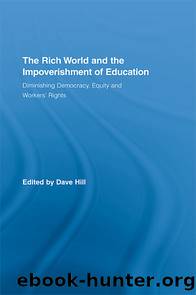The Rich World and the Impoverishment of Education by Hill Dave;

Author:Hill, Dave;
Language: eng
Format: epub
Tags: Education
Publisher: Taylor & Francis Group
Published: 2008-10-02T00:00:00+00:00
6
Changing the Tide of Education Policy in Finland
From Nordic to EU Educational Policy Model
Joel Kivirauma, Risto Rinne, and Piia Seppänen
INTRODUCTION
Numerous authors around the world hold the opinion that we are witnessing the transition to an entirely new historical era, which has been referred to by various names, such as globalization, risk society, neoliberalism, and so on (e.g., Bauman, 1996, 1998; Beilhartz, 2000; Beck, 1992, 1997; Castells, 1997; Castells & Himanen, 2002; Giddens, 1995; Sennett, 1998). In this âglobal network society,â education and social exclusion are also making new connections and searching for new routes and forms. Raising educational standards in the global market offers little insight into how the question of social justice is to be addressed (Brown & Lauder, 2006, p. 334).
Radical changes in educational policy and governance have occurred all around the postindustrialized world in recent years. Mark Olssen (2006, p. 263) has distinguished two interrelated phenomena in globalization: (1) changes in science and technology, and (2) discursive system pursued at the policy level. Our chapter concentrates on the latter of those levels; in other words, we are looking at the impacts of neoliberal policy changes. We are examining the new governance of education and the new mechanisms of educational and social exclusion. Our aim is to examine the changing position of education as a definer, producer, and result of social exclusion by analyzing and comparing Finnish educational policy changes with more general European trends. The effects and consequences of these changes are not yet very clear, but at least in Finland there seem to be astonishingly strong trends of diversification of the whole old honorable Nordic socialâdemocratic comprehensive school.
When comparing educational policy in different European countries, each educational system and type of governance should be contextualised in wider socio-cultural frames. As there are different models of welfare states, are there also âNordic,â âcorporated,â âneoliberal,â and âperipheralâ welfare routes or models1 in the field of educational policies and governance? And if so, are these models now in the process of becoming integrated into a kind of âEU educational policy modelâ? (Kivirauma, Rinne, & Seppänen, 2003; Rinne & Kivinen, 2003; Rinne, Aro, Kivirauma, & Simola, 2003; Kallo & Rinne, 2006).
Educational exclusion is most often seen as the problem of inequality of educational opportunities and partly as a consequence of this, inequality of social opportunities. Some groups have poorer resources and material opportunities than others on the educational market. This has been the main argument and rationale behind carrying out comprehensive school reforms in many welfare states after World War Two. But on the other hand educational exclusion also deals very deeply with different cultural ways of life, cultural values and languages, power relations and the diversification of knowledge. Discursive rules construct the subjects and subjectivities that differentiate various groups. We need to research the principles of reason and conduct that classify, differentiate, and divide the subjectivities of actors and agents through practices of normalization.
This chapter is connected to a comparative research project funded by the European Union that began in late 1990s, âEducational Governance and Social Inclusion and Exclusionâ (EGSIE).
Download
This site does not store any files on its server. We only index and link to content provided by other sites. Please contact the content providers to delete copyright contents if any and email us, we'll remove relevant links or contents immediately.
The Art of Coaching Workbook by Elena Aguilar(50168)
Trainspotting by Irvine Welsh(21078)
Twilight of the Idols With the Antichrist and Ecce Homo by Friedrich Nietzsche(18324)
Fangirl by Rainbow Rowell(8819)
Periodization Training for Sports by Tudor Bompa(7946)
Change Your Questions, Change Your Life by Marilee Adams(7405)
This Is How You Lose Her by Junot Diaz(6476)
Asking the Right Questions: A Guide to Critical Thinking by M. Neil Browne & Stuart M. Keeley(5387)
Grit by Angela Duckworth(5322)
Red Sparrow by Jason Matthews(5225)
Paper Towns by Green John(4826)
Room 212 by Kate Stewart(4767)
Ken Follett - World without end by Ken Follett(4467)
The Sports Rules Book by Human Kinetics(4098)
Housekeeping by Marilynne Robinson(4084)
Double Down (Diary of a Wimpy Kid Book 11) by Jeff Kinney(3958)
Papillon (English) by Henri Charrière(3942)
The Motorcycle Diaries by Ernesto Che Guevara(3804)
Exercise Technique Manual for Resistance Training by National Strength & Conditioning Association(3798)
